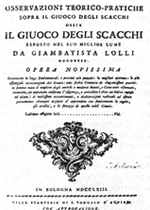Lolli Giambattista (04.06.1769)
 A native Nonantola, near Modena, one of three talented Italian players (the others were Ercole del Rio and Ponziani) who made up the Modena School. Lolli published a comprehensive work of some 632 large pages, “Osservazioni Teoretico – Pratiche sopra il giuoco degli scacchi” (Modena, 1763), in which he dealt with everything that was known at the time about the openings and the endgame. The work written in the form of a letter included del Rio’s broadside against Philidor. The first part of Lolli’s book contains the openings given in Del Rio’s earlier book, and the second part contains new variations provided by Del Rio. To the bare lines of play given by his master, whom he never contradicts, Lolli has added, with Del Rio’s approval, extensive annotations. The openings coverage is not wide-ranging compared, for example, with Cozio’s book published three years later. More than 40 percent of the two parts deal with the Italian openings. The third part of the book, in which Lolli comes into his own, consists of the best examination of the Endgame given up to that time, and 100 positions (studies and problems). Besides important analysis of the endgame R+B v. B he discovered in the endgame Q v. B+B a Fortress, which, according to computer research by Thompson in 1985, appears to be the only known drawn position in this endgame. Lolli’s book was popular and his problems were frequently used by other authors, including Heinse, and in the earliest newspaper columns. In 1817 a book containing the 100 positions was published in Verona: the solutions were printed in Standard Notation, its first use in Italy. (WH, see illustration in German encyclopedia).
A native Nonantola, near Modena, one of three talented Italian players (the others were Ercole del Rio and Ponziani) who made up the Modena School. Lolli published a comprehensive work of some 632 large pages, “Osservazioni Teoretico – Pratiche sopra il giuoco degli scacchi” (Modena, 1763), in which he dealt with everything that was known at the time about the openings and the endgame. The work written in the form of a letter included del Rio’s broadside against Philidor. The first part of Lolli’s book contains the openings given in Del Rio’s earlier book, and the second part contains new variations provided by Del Rio. To the bare lines of play given by his master, whom he never contradicts, Lolli has added, with Del Rio’s approval, extensive annotations. The openings coverage is not wide-ranging compared, for example, with Cozio’s book published three years later. More than 40 percent of the two parts deal with the Italian openings. The third part of the book, in which Lolli comes into his own, consists of the best examination of the Endgame given up to that time, and 100 positions (studies and problems). Besides important analysis of the endgame R+B v. B he discovered in the endgame Q v. B+B a Fortress, which, according to computer research by Thompson in 1985, appears to be the only known drawn position in this endgame. Lolli’s book was popular and his problems were frequently used by other authors, including Heinse, and in the earliest newspaper columns. In 1817 a book containing the 100 positions was published in Verona: the solutions were printed in Standard Notation, its first use in Italy. (WH, see illustration in German encyclopedia).



